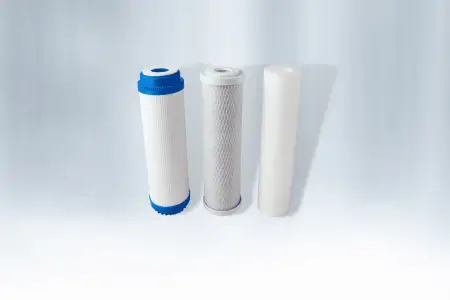A sediment filter removes unwanted dirt particles from your water supply. It is installed at a point where the water enters your home. As water passes through the sediment filter’s membrane, it is stripped of dust, debris, and rust particles.
Here’s why that’s crucial.
Sediment build-up in your water supply can ruin your appliances, choking your fixtures, valves, and hot water heaters. It may also prevent filtration systems like ultraviolet purification, ion exchange, and reverse osmosis from operating at their maximum efficiency.
That’s not all.
Rust flecks in water can leave your water unappetizing (at worst) and discolored (at best). Sediment filters prevent all of this from happening, which is why they are an integral part of most water filtration systems. Read on to know more.
What is a Sediment Filter?
Sediment filters capture and eliminate suspended particles like dirt and debris from your water. Sediment is a common term for all the particles in the water that aren’t liquid. These particles might become a part of your water supply from various sources.
For instance:
- Rainwater can introduce silt, grains, soil, and grain of sands to your groundwater supply
- Corroded galvanized plumbing can become a source of rust for your water supply
- Decomposition of plants and animals can sully your groundwater
- Soil erosion can introduce sediments to your water supply
All of this is to say that sediments can become a part of your water supply for various reasons. You can’t stop that from happening. What you can do is install a sediment filter where water enters your home, so that your home’s water supply is free of particulate matter.
What Does a Sediment Filter Remove?
A sediment filter removes visible particulate matter from water. They include silt, grains, specks of rust, and soil. It can also capture and remove dust, dirt and debris particles that fall within its micron-rated capacity. Sediment filters can also remove turbidity from water.
Turbidity is the cloudiness caused by the large presence of suspended solids in water. It forces water to turn orange, yellow, or brown. Water that has high turbidity might be shielding bacteria and may cause headaches, cramps, and nausea. It may stain pipes over time, too.
What Doesn’t a Sediment Filter Remove?
A sediment filter doesn’t remove heavy metals, bacteria, chemicals, or dissolved particulate matter. It can’t improve the smell or taste of water, either. All a sediment water filter could do is act as a preservative and defensive filtration method. Here’s what that means.
Sediment filters on their own might not be enough to purify your water supply, especially if it contains heavy metals, chlorine or lead. They are at their most effective when used in conjunction with other filtration methods, like ultraviolet purification or reverse osmosis.
What is a Sediment Filter Used for?
A sediment filter is used as a pre-filter for various water treatment systems. Any water supply that has dirt, debris or fine particulate could do with a sediment filter. Sediment filters also help the following water filtration systems work efficiently:
1) Ultraviolet Purification
- 40W 12GPM unit, 37.2*2.5 in stainless steel chamber, 3/4” (DH20, OD 1.05...
- Easy installation, No plumber needed. Horizontal installation and metal...
- NO CHLORINE, Chemical Free and Environmentally Friendly. No change at...
- Safety and Reliable, 304 stainless steel and Quartz glass are proved to be...
Ultraviolet (UV) purification systems neutralize bacteria, parasites and microorganisms using germicidal UV wavelengths. UV light renders these living organisms unable to reproduce by damaging their DNA. UV purification is a highly-effective filtration mechanism for microbiologically dirt water.
Still, on their own, UV purification filters cannot remove the turbidity of water. It’s difficult for the UV rays to penetrate water turbidity, allowing bacteria to hide behind particulate matter. That’s why UV filters need a sediment pre-filter to function at their maximum performance.
2) Reverse Osmosis
Reverse osmosis (RO) systems remove impurities from water by passing it through a semi-permeable membrane. The membrane allows the water to pass through, but captures salts, metals, and dissolved solids. It can also successfully remove bacteria, viruses, lead and mercury from water.
RO systems, too, need a sediment pre-filter. The water rejected by these systems is drained through a tiny flow restrictor. The flow restrictor controls the system’s recovery ratio and keeps the membrane pressurized. A sediment pre-filter, by removing dust particles, saves the flow restrictor from clogging.
3) Carbon Filter
Carbon filters remove chlorine and chloramines from water to restore its fresh taste. While they can filter out sediments on their own, dirt and dust particles can quickly clog their filter media, especially if you’re filtering large quantities of water.
Since sediment filters cost less than their carbon counterparts, and to prolong the life of your carbon black filter media, it’s suggested to install a whole house sediment filter. Doing this won’t only save you money. It will also allow your carbon filter to operate at maximum efficiency.
4) Whole House Filtration
A whole house sediment filter will save you a lot of money and headaches. If you’re allowing sediments inside your home’s piping, it’s only a matter of time before they start clogging, slowing the water flow and pressure in your home. That’s not all.
Sediments also damage washing machines and dishwashers, hurting their shelf life. Water heaters, too, will malfunction and clogged if you allow sediments to accumulate inside them, reducing their capacity, efficiency and overall life expectancy. Only a whole house sediment filter can prevent this from happening.
Types of Sediment Filters
There are two main types of sediment filters, including spin down sediment filter and cartridge sediment filter. Spin down filters use centrifugal force to purify water of sediments, while the cartridge filters use a physical media to separate sediments from water.
Here are the two major sediment filter types:
Spin-down filters
Spin-down filters rely on centrifugal force to remove sediments from water. These are less-common sediment filters that are mainly used for well water sediment removal. They are installed as a first-stage filter, which is why they are also known as a pre-filter.
You’re likely to find spin-down filters in a whole house filtration system, especially one that is designed to treat well water. Make sure that the entire filtration system is as close to your home’s water entry point as possible – only then your house will receive clean and sediment-free water.
How spin-down filters work?
Spin-down filters work on the principle of centrifugation. Water enters the filter at the top before being diverted into a clear chamber. Once it’s inside the chamber, the water is spun around. This throws the suspended particles against the chamber’s housing, before they settle at the chamber’s bottom.
The ‘filtered’ water is then pass through a mesh screen, anywhere between 100 and 15 microns in size, to remove further sediments. Keep in mind that spin-down filters can only remove large chunks of dust and debris. You cannot count on them to remove small particulate matter.
Pros of spin-down filters
- Do not need disposable sediment filter cartridge
- Easy to install and won’t affect water pressure
- Can handle water flow rates of up to 80 GPM
Cons of spin-down filters
- Might not remove small particulate matter
Cartridge filters
Most of you might already be aware of the working principle of cartridge filters. A cartridge filter is either installed in their own housing at a water line, or they share the housing with multiple other filters in a multi-stage water filter.
Regardless, most cartridge filters work as pre-stage filters. They remove sediments from water before other types of filtration – RO, UV, ion-exchange, etc. – come into play, regardless of whether just one big tank or separate cartridges are involved.
Cartridge filters are available in two types: spun-cartridge and pleated cartridge.
How spun-cartridge filters work?
Spun-cartridge filters owe their name to their design. They are cylindrical in shape and are made of multiple layers of melted, spun polypropylene. Water going through a spun-cartridge filter experienced more thorough filtration because it has to travel to multiple stages of media.
The largest, outer layer of spun-cartridge filters has the highest micron-rating, which means it can remove the largest particles, such as grains of dirt and sand. As water passes one layer after the other, it encounters a media with lower micron-rating than the previous one.
This is what makes spun-cartridge filters capable of eliminating sediments of all sizes. It also allows you to use these filters with most filter systems out there, making spun-cartridge filters one of the best in terms of convenience and utility.
Pros of spun-cartridge filters
- Remove sediments of all sizes
- Can work with any filter system
Cons of spun-cartridge filters
- Pricey
How pleated cartridge filters work?
Similar to their spun-cartridge counterparts, pleated cartridge filters also owe their name to their design. The filtration media inside them has a pleated, folded design. One that also has a high micron rating, enabling the pleated cartridge filter to remove a large quantity of sediments.
Having said that, pleated cartridge filters are up to no good when it comes to removing smaller sediments from water. That’s because they have a single high-micron design throughout, though you can still use them as a pre-filter in your whole house water filtration setup.
Provided you intend to do just that, make sure an activated carbon filter follows the pleated cartridge filter in your setup. Doing this will ensure that the smaller particles let through by the pleated filter are filtered out with the carbon filter’s small micron rating.
Pros of pleated-cartridge filters
- Affordably priced
- Remove large sediments
Cons of pleated-cartridge filters
- Cannot remove small-sized sediments
Do You Need a Sediment Filter for Well Water?
A whole house sediment filter is advisable if you use a well as your water source. Groundwater almost always harbors a greater quantity of sediments than city water. Flooding, soil erosion and storm water runoff can all flung unwanted sediments into your well.
Also, before reaching the well, water passes through semipermeable rocks, which can introduce sand and silt to your water supply. All of this is to say that if you use well water for your household, you must opt for a sediment filter to get a pure water supply for your home.
Frequently Asked Questions
What is a good sediment filter?
The best sediment filters have their micron ratings somewhere between 5 and 30. They come in a whole-house water filtration setup, where the sediment filter acts as a pre-filter and is followed by either UV or RO filters, which can take care of dissolved impurities that the sediment filter can’t remove.
Can you reuse a sediment filter?
You can clean and reuse your old sediment filter if its condition isn’t worse for the wear. However, if you want to enjoy the main advantage of whole-home water filtration – which is pure water – reusing an old filter might not be the best choice.
Conclusion
A sediment filter provided you with the best of both worlds. On the one end, it protects your pipes, faucets, fixtures, water heaters and other water appliances from corrosion. This ensures that these devices’ maintenance costs are kept at a minimum.
On the other end, and if used in a whole-house water filtration system, a sediment filter boosts the efficiency of other filters as a pre-filter. It does that by removing those sediments which, if allowed to pass through, can stain the interior of the upcoming filters, compromising their efficiency.

I graduated with a degree in Chemical Engineering and have written for a number of nationally recognized publications in the home improvement space. My skills include fluid mechanics and process engineering and I have worked on numerous projects, including in waste water flow rate calculation and heat balance of steam rollers in the paper industry. My goal as a technical writer is to make complicated topics easy to understand for the average person.

